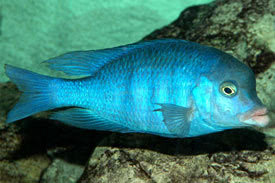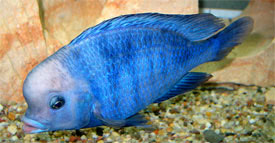
 Magyarul / Hungarian
Magyarul / Hungarian


- Scientific name: Cyrtocara moorii
- Common name: Moori, Blue lump head, Blue dolphin cichlid
- Group: Cichlids
- Habitat: Eastern Africa, Lake Malawi
- Size: 20 cm.
- Biotope: Found above sandy areas in Lake Malawi.
- Social behavior: A peaceful and territorial fish that will form schools when kept in a large tank. Keepone male with several females.In Lake Malawi, the Moori is found in schools with Fossorochromis rostratus.
- Diet: Live, crustaceans, insect larvae, aquatic insects, Tubifex, beef heart, chopped meat, tablets, pellets
- Breeding: Quite easy
- Tank: Minimum 300 litres
- Population: 1 male and 2 females for 500 litres
- Decoration: The background should be large rock formations, while the foregroundshould be coral sand with a scattering of small stones.Large open swimming areas are very important for this fish. Sturdylive plants can be used.
- Temperature: 25-26°C
- pH: 7.5-8.8
- Hardness: 10-20 NK°
- Lifespan: 10-12 years
Description: An oval-shaped cichlid with a characteristic cranial bump on its forehead. Thebase of caudal fin is very slender. The body is bright blue to dark bright blue. Seven to eight faint vertical stripesare present, although they are often difficult to detect. The fins are the same color as the body.
The male may be slightly larger with brighter colors.
Use a large breeding tank with one male and three or four females. The water chemistry should have a pH from 7,5-8,5, a water hardness from 10-16 dH, and a temperature of 79-82°F (26-28°C). Make frequent partial water changesto keep the parents in top condition. The female lays from 20-60, and occasionally as many as 100, on a rock. Thetakes the eggs into her mouth where they are incubated for 20-25 days. The female continues brood care afterthe young emerge from the mouth.Start feeding with small live foods. The young grow quickly when kept under a regimeof frequent partial water changes.








